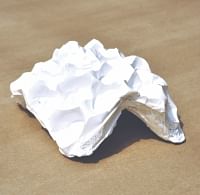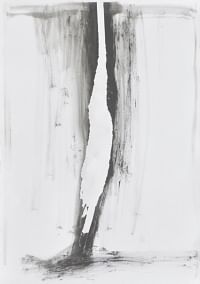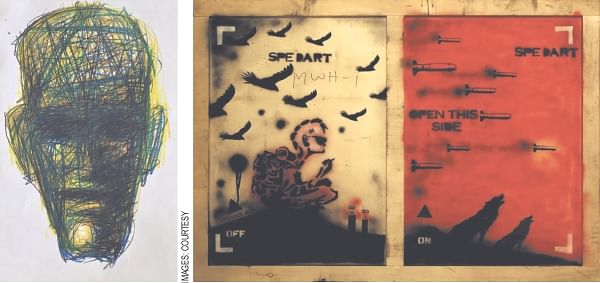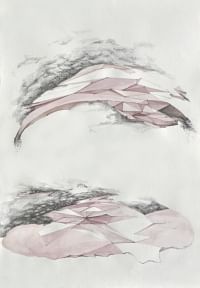| Home - Back Issues - The Team - Contact Us |
 |
| Volume 11 |Issue 22| June 01, 2012 | |
|
|
Exhibition Freefalling Lines Young artists are being showcased in a group drawing exhibition, with the hope that it will not only give them a stage in Bangladesh but also their contemporary work a place in the international art world Soraya Auer
Step out of Dhaka's busy traffic into the calm serenity of the Bengal Art Lounge this week and you will question whether you have slipped into an art gallery somewhere else in the world. The current exhibition, titled 'Freefall', showcases the drawings of five known and up-and-coming young artists: Shehzad Chowdhury, Yasmin Jahan Nupur, Mohammad Hasanur Rahman, Salzar Rahman and Ayesha Sultana. “I liked very much the idea of having an exhibition based on works on paper,” explains Giorgio Guglielmino, the Italian art critic and collector who curated the show. “I think works on paper are much more immediate and show a creative spark [in the art and artist]. Paintings can take a long time to create and lack the spontaneity I wanted to show in these artists.” The spontaneity and fluidity the curator refers to, is something he says he sees in contemporary dance. “The creative process and freedom of expression that you can show in a drawing is very similar to the freedom that you have in contemporary dance compared to classical dance,” says Guglielmino. A 1987 film of contemporary dance by British choreographer, Gaby Agis, of the same name, 'Freefall', is also in the gallery, and helps give the exhibition's theme life and coherence.
The carefully selected pieces use a range of materials, from watercolour paint to staples and human hair, on paper of different kinds and sizes. Despite the brief to artists to work on paper, the exhibition also promotes urban-cool style graffiti on a wooden crate by Salzar Rahman. Considering the range of work, it wouldn't be a surprise to feel overwhelmed by the variety and underwhelmed by the quality. However, there is nothing contrived about the works on display and if anything, the simplicity and strength of the collection is to the credit of both artists and the curator, the latter of which is a role not commonly seen in Bangladesh's art world. “One of the weak points of the contemporary art scene of Bangladesh is that the role of the curator is not common at all,” says Guglielmino, who came to Bangladesh more than a year ago as the Italian Ambassador to Dhaka. “I've found that in solo shows they try to present too many works and the walls become too crowded. Especially with contemporary art, there has to be harmony in the overall presentation of the works. “I think the role of the curator is a sort of bridge between the works and viewer. [The curator] should help the viewers better appreciate the works and should help the works be displayed in a proper and more appropriate way.” While the five artists and their work fit in with Guglielmino's vision, the young Bangladeshi artists, aged between 26 and 37 years, were not brought together by choice but rather by chance. Their drawings, hanging together, symbolically depict this. Yasmin Jahan Nupur's pencil diamond shapes and watercolour splodges are in stark contrast to Md Hasanur Rahman's Frankeinstein-esque faces and dark female forms, and yet they complement one another. Also, Shehzad Chowdhury's bold lines and curves, made with graphite, ink and charcoal, are not so alien to Ayesha Sultana's shapes and lines. Sultana's series of painted staples on rice paper are particularly beautiful and mesmerising at a distance.
Additional to the artwork on display, in the centre of the main gallery, there are a few purple pieces of future historical importance. “I didn't want to label them because I hoped someone might notice and recognise them,” says Katerina Don, the assistant manager of Bengal Art Lounge, with a small smile. “They're pieces of Wonderland [the amusement park] because [the government] was breaking it down while we were assembling this show and it seemed right to have something of that place that was in our lives for so long.” Don, who has lived in Bangladesh for 15 years, adds, “It goes with our exhibit's theme, as it's something that has recently fallen.”
The exhibition hopes to sell all the art pieces but more importantly, Guglielmino says, to show off this new wave of contemporary artists. “It's important to have somebody who can spot a good artist and can promote them. The collectors should have a very important role, especially with young artists, because while they may not be expensive, they need recognition and need to be pushed ahead.” The curator believes the liberating nature of contemporary art allows the sketch, the watercolour, and the oil painting to be as important as each other. He adds, “Now you can really express yourself in so many ways. I would be very pleased if a [young] generation of collectors would come out in Bangladesh, collecting, of course, the contemporary.” While admiring the simple sketches and more elaborate shapes, there is something clearly universal about all the pieces – there is nothing ethnic or nationalistic about the style or creations themselves. It was as if the art is liberated of its locality and creator's cultural background. “Some people may expect to see some [ethnic] influence but this is the 21st Century,” says Don, “and this is modern art. It won't happen overnight but slowly, with one or two pieces at a time being taken up by galleries abroad, I'm really hopeful that Bangladesh will be recognised for its contemporary art. ” Feeling like you could be looking at good art anywhere else in the world is certainly a start. The group drawing exhibition 'Freefall' will run until June 11 at Bengal Art Lounge, 60 Gulshan Avenue, Circle 1, Dhaka. It is open daily 12 to 8pm.
Copyright
(R) thedailystar.net 2012 |
||||||||||||||||



